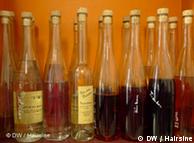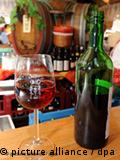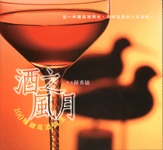Basking With Rosés
Published: June 9, 2009
IT began seemingly as a brief flirtation more than five years ago, this American affection, if not passion, for rosé wines. It was something new, something different. Fashion magazines and other arbiters of cool zeroed in on rosé like a rising hemline and anointed it the “It” wine.
But “It” wines are fleeting, like a whiff of a captivating perfume, or the beads of condensation on a cool glass in the afternoon sun.
This thing with rosé has evolved into a long-term relationship that shows no signs of fading.
It used to be that when warm weather rolled around, critics would try to talk up the virtues of rosé as a wine that deserved a place at the table, better yet a lunch table, best of all a lunch table outdoors, near the water, with pale blue skies, the smell of the sea and whitewashed walls thrown in for atmosphere.
Few Americans took rosés seriously, though, and the wines languished, except in their bastardized “blush” guises as sweetened wine confections that may have a place, yes, though rarely at the table.
But when Americans took that fashionable leap, they discovered what Mediterranean cultures knew all along: rosé is the quintessential daytime wine, perfect for outdoors, wonderful in the summer.
With few exceptions, rosés are simple wines, but that simplicity enhances their allure. As with cooking over a grill, drinking rosé emphasizes the elemental, uncomplicated appeal of the fresh, raw material, which makes them generally undemanding wines. Anything wrong with that? Of course not. Most rosés are like beach reading, but as anybody who has ever been stuck seaside with a dull book knows, a bad rosé is no picnic.
To assess this summer’s offerings, the wine panel recently sampled 25 bottles of rosé. Our only restriction was price: We wanted to spend $10 to $20 a bottle, but no more than that.
For the tasting, Florence Fabricant and I were joined by Mark Lugo, the sommelier at BLT Fish in New York, and Karen King, a former sommelier who is now a sales manager at Winebow, an importer and distributor.
In that price range we could have found hundreds of bottles. So just to be clear: The list of the top 10 wines in our tasting represents only those we liked in that small sample, although I think it offers an accurate cross-section of what is generally available.
For consumers, the news is good. We were encouraged by how many wines in the tasting were actually dry, without the soda-pop dollop of sugar that can turn a rosé into a wine cooler.
The wines we liked best were not overly fruity nor were they obvious. Instead, they emphasized mineral flavors, along with floral and herbal aromas. They were savory. In fact, that was the word that came to mind in describing our No. 1 wine, a counterintuitive choice in every way.
The wine, a 2008 Robert Oatley, came from the Mudgee region of Australia, which is not exactly a rosé destination, and was made from the sangiovese grape, which you don’t often see contributing to a rosé. Nonetheless, it had that savory quality we really liked, along with restrained flavors, a tangy presence and an inviting texture.
Texture — how the wine feels in the mouth — was a crucial ingredient in the bottles we liked best. As I said, these were not obvious wines, conveying powerful fruit flavors and aromas. They were more evocative, with their allure stemming from their ability to transport.
In previous rosé tastings, we very much liked American, Spanish and Italian wines. But in this tasting, French rosés dominated, taking 7 of the top 10 spots. These included rosés in many different colors and styles.
Our No. 2 bottle, the 2008 Beaujolais Rosé d’Folie from Jean-Paul Brun, was made entirely from gamay. It, too, had a wonderfully delicate texture with unexpected nuances in the flavor. Our No. 4 wine, the ’08 Château de Peyrassol from the Côtes de Provence, was a more typical southern French rosé, made of grenache, cinsault and syrah. It is pure pink with floral aromas and pleasing mineral flavors.
Meanwhile, our No. 5 wine, the 2008 L’Alycastre from Domaine de la Courtade, also from the Côtes de Provence, made of grenache, mourvèdre and the obscure tibouren, was an archetype rosé — chill, pour, drink and enjoy. Our No. 6 wine, the ’08 Château d’Oupia from the Minervois, was a spicy, peppery wine. At $13 it was our best value, though in this $10 to $20 range none of our favorites were bad values.
It’s the rare rosé that benefits from age. Two that come to mind are the Rioja from Lôpez de Heredia and the Palette from Château Simone. Both are superb wines, but out of our price range. All of our favorites were from the 2008 vintage.
The most unusual in the bunch was our No. 9 wine, a 2008 Txakolina from Ameztoi in the Basque region of Spain. Dry white Txakolinas have grown highly popular in the last few years, but you don’t often see a rosé. This wine had a bit of effervescence, and surprising flavors of tropical fruit.
The Txakolina was made by blending the red hondarrabi beltza grape with white hondarrabi zuri grapes, a method that may be ancient in the Basque region but is prohibited in much of Europe. Otherwise, all of our favorites were made in the traditional manner of crushing red grapes only and allowing the juice to macerate only briefly with the pigment-bearing skins.
The European Union had proposed relaxing these rules, which would have allowed producers everywhere in Europe to blend red and white to make rosé. But after heavy lobbying from rosé producers, who feared that their more painstaking methods would give way to cheap blends of poor wines, the union on June 8 withdrew the proposal.
Good rosé may well be more than a fleeting memory.
Tasting Report: Sipping Under the Sun
Robert Oatley
$16
★★★
Mudgee Australia Rosé of Sangiovese 2008
Bone dry with lovely texture and balanced, savory mineral flavors.
(Importer: Oatley Wines, Petaluma, Calif.)
Jean-Paul Brun
$15
★★★
Terres Dorées Beaujolais Rosé d’Folie 2008
Rich yet delicate with restrained fruit flavors and plenty of nuances. (Louis/Dressner Selections, New York)
Wild Rock
$15
★★ ½
Hawkes Bay New Zealand Vin Gris Rosé 2008
Crisp and tangy with dry, refreshing flavors. (Kobrand, New York)
Commanderie de Peyrassol
$15
★★ ½
Côtes de Provence Château de Peyrassol 2008
Pink, dry and surprisingly rich with pleasing floral aromas.
(Rosenthal Wine Merchant, New York)
Domaine de la Courtade
$14
★★ ½
Côtes de Provence L’Alycastre Rosé 2008
Dry, earthy and straightforward; chill, pop, pour and drink.
(Winebow, New York)
BEST VALUE
Château d’Oupia Minervois Rosé 2008
$13
★★ ½
Floral aromas with round, peppery fruit flavors.
(Louis/Dressner Selections, New York)
Château de Rouët
$13
★★ Côtes de Provence Coeur Estérelle 2008
Delicate and straightforward with dry, gentle citrus and berry flavors. (Village Wine Imports, New York)
Commanderie de la Bargemone
$16
★★
Coteaux d’Aix en Provence Rosé 2008
Dry and earthy with intriguing floral and berry flavors.
(Hand Picked Selections, Warrenton, Va.)
Ameztoi Getariako Txakolina Rubentis 2008
$20
★★
Dry, tangy and lightly effervescent, with crisp, almost tropical fruit
flavors. (De Maison Selections, Chapel Hill, N.C.)
Jean-Maurice Raffault Chinon Rosé 2008
$17
★★
Tangy aromas and flavors of earth, herbs and almonds.
(V.O.S. Selections, New York)






![[Beer Manufacturers]](http://s.wsj.net/public/resources/images/PJ-AO750A_pjBEE_DV_20090317215239.jpg) Anne Ryan for The Wall Street Journal
Anne Ryan for The Wall Street Journal![[Discount Wine]](http://s.wsj.net/public/resources/images/PJ-AO499_pjWINE_DV_20090218192047.jpg) Reuters
Reuters



